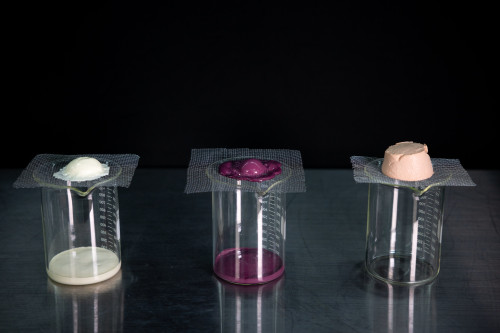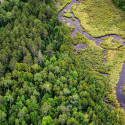Bringing delight by investigating a no-melt ice cream
On a hot summer day, nothing hits the spot quite like ice cream, especially here in the Dairy State. But while a frozen treat can help you cool off, it also puts you in a race against the clock to finish your scoop before it becomes a puddle — or worse, a sticky mess coating your hands, favorite shirts and new jeans.
Cameron Wicks, a PhD student in the University of Wisconsin–Madison’s Department of Food Science, is working on a new technology that adds naturally occurring compounds to ice cream to prevent it from wreaking so much havoc.
“When you have normal ice cream, it will become a puddle of liquid in no time,” says Wicks. “However, we learned that adding polyphenols to ice cream can create a product that holds its shape for over four hours at room temperature. That’s pretty close to a no-melt ice cream.”
Polyphenols are compounds that are found naturally in foods like green tea, blueberries and cranberries and are known for their health benefits. By incorporating polyphenols into a standard ice cream recipe, Wicks was able to study how they interact with the ice cream’s milk fat and protein structures.
Wicks found that as she added more polyphenols to ice cream, its viscosity increased, meaning it became thicker.
Polyphenols don’t prevent the ice in ice cream from melting at room temperature. Instead, they help create a network between the cream’s fats and proteins that resists the flow of melting ice. In other words, polyphenols help the ice cream hold its shape, leading to fewer drips when left at room temperature.

Wicks tested the melting rates of ice creams mixed with varying amounts of polyphenol extract. Photo: Michael King
After creating ice cream samples with various levels of polyphenol extract, Wicks ran some meltdown tests. She positioned ice cream samples on a wire mesh, each above its own beaker. The beakers sat on scales to record the weight of the dripping ice cream. With this data, she measured the melting rate, assessing how quickly each ice cream sample melted. Wicks also took photos of the ice cream as it melted over several hours.
These measurements and visuals, along with microscopic images of the ice cream samples’ ice crystals, fats and proteins, helped Wicks get a better understanding of what polyphenols do to ice cream.
Prior research had shown that polyphenols can decrease the ice cream’s melting rate, but little information was available to explain how that happened. At UW–Madison, Wicks was able to combine the expertise from Professor Brad Bolling’s lab, which had been studying polyphenol chemistry for a while, with the expertise of Professor Richard Hartel’s lab, which has the scoop on ice cream science.
“Ice cream already brings delight and happiness to many people around the world. So, to be able to make a new novelty — and with this new technology — is a pretty cool thing to do,” Wicks says.
Polyphenols seem to have a similar effect as the stabilizers already used in ice cream, she says. These stabilizers help to minimize ice crystal growth in ice cream and preserve its quality during storage so it’s more resilient through its distribution from the factory to the supermarket and all the way to the back of your freezer. During that process, ice cream often melts and refreezes too, creating a gritty texture that ends a product’s shelf life.
Right now, stabilizers in ice cream include guar gum, locust bean gum and carrageenan. Wicks sees an opportunity for those stabilizers to be replaced with more recognizable and natural ingredients like green tea or blueberry extracts that contain polyphenols. Polyphenols could also help in the distribution of other foods to areas that don’t have great access to refrigeration.
Wicks acknowledges that consumers currently expect ice cream to melt. Incorporating polyphenols into ice cream can also affect how it tastes, and Wicks is interested in investigating what an acceptable amount of polyphenols may be for a polyphenol-enriched ice cream — but that’s a project for another day.
“Ice cream is such a complex system,” she says. “Being able to understand all of the science behind it, you can make food items better, more sustainable, and you can make better systems that feed the world.”
Subscribe to Wisconsin Ideas
Want more stories of the Wisconsin Idea in action? Sign-up for our monthly e-newsletter highlighting how Badgers are taking their education and research beyond the boundaries of the classroom to improve lives.
Tags: food science, The Wisconsin Idea



